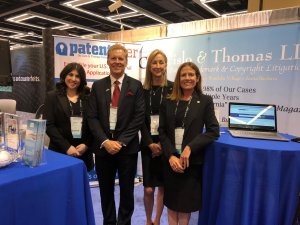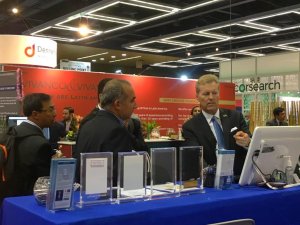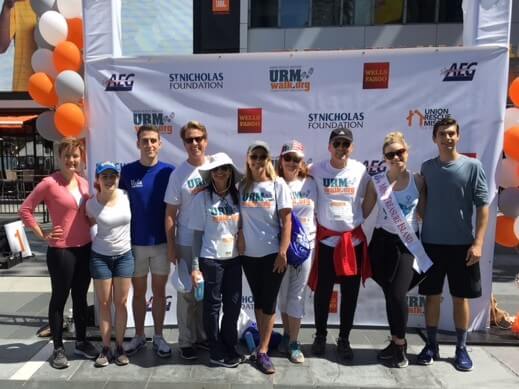INTA 2018 In Seattle
Cislo & Thomas LLP proudly exhibited at the 140th Annual International Trademark Association meeting from May 20 to 23. Over 10,000 patent and trademark attorneys from more than 150 countries gathered together in Seattle to network and discuss new opportunities in international intellectual property.
At INTA, Cislo & Thomas LLP presented its PatentFiler.com online provisional patent filing portal, which was well-received by intellectual property attorneys around the world. Cislo & Thomas LLP plans on attending the conference next year in Boston, with more exciting and cutting-edge technology that will help both clients and attorneys file quality provisional patent applications quickly and at a reasonable cost.
It was a joy to reconnect with old friends from all over the world. while meeting some new ones as well.


International Design Patents
Takeaway: If you plan on seeking design patent protection internationally, you should consider filing an industrial design application with the World Intellectual Property Organization to streamline the procedural process.
When seeking design patent protection on the design of your product, it is important to consider filing an industrial design application with the World Intellectual Property Organization (“WIPO”). WIPO allows you to file a single international application that will seek design protection in 68 different countries. An industrial design patent gives you the ability to claim exclusive rights over the ornamental or aesthetic aspects of an article that you have created.
WIPO’s international design system allows you to submit up to 100 designs in a single application to streamline the process of expanding your protection worldwide. To file for industrial design protection you must file an application with the International Bureau (“IB”) and then designate which countries you would like to seek protection.
Once the application has been submitted to the IB and the countries have been designated, the IB checks to see that your application complies with all formal requirements. Consolidating the formal requirements such as initial procedural issues helps simplify the process so you do not have to track numerous deadlines, file in different languages, or pay in different currencies. You also have the benefit of filing yet not receiving objections from every country in which you have applied.
If your application meets the formal requirements of the application process, your design will be added to the international designs bulletin by WIPO. At this stage, the designated countries will each begin their examination of the application.
Like a PCT application, substantive examination is done by each country for objectives, such as novelty of the design, to determine if your design will be afforded protection in that specific country. It is important to remember that this international procedure does not provide the ultimate decision as to whether protection will be afforded in each country individually.
Overall, even though you still have to go through a substantive examination process in each individual country, the international industrial design application process greatly streamlines the procedural process for seeking protection internationally.
Update on Pleading Standards for Direct Infringement Patent Cases by C&T Partner Mark D. Nielsen
 Takeaway: Pleading infringement of patent infringement has become easier.
Takeaway: Pleading infringement of patent infringement has become easier.
On May 1, 2018 in Disc Disease Solutions, Inc. v. VGH Solutions, Inc., the United States Court of Appeals for the Federal Circuit addressed the proper standard for pleading a direct infringement claim in a patent case. The appeal arose from a grant of a motion under Rule 12(b)(6) for failure to state a claim.
One of the interesting facts in the case was that it was filed on November 30, 2015, one day before the December 1, 2015 amendments to the Federal Rules of Civil Procedure, which abrogated Rule 84 and Form 18. Rule 84 included forms for pleading certain types of claims, with the language in such forms being deemed acceptable to meet federal court pleading standards. Form 18 continued to suffice even after the Twombly/Iqbal cases from the Supreme Court seemingly tightened pleading standards in federal cases.
In the Disc Disease case, the district court applied the post-December 1, 2015 pleading standard (i.e., Twombly/Iqbal) and dismissed the complaint. The district court held that a complaint for direct patent infringement that attached the asserted patents, identified the accused products, showed photographs of the accused products, and stated that the accused products met “each and every element of at least one claim” of each of the patents “either literally or equivalently” was not adequately pled under the Twombly/Iqbal standard. The plaintiff moved for reconsideration asking the district court to allow it to file a first amended complaint because the abrogation of Rule 84 and Form 18 was an intervening change in the law. The district court denied this motion, as well as an additional attempt by plaintiff on other grounds to file a first amended complaint. An appeal to the Federal Circuit ensued.
The Federal Circuit did not address whether the Form 18 standard or Twombly/Iqbal applied, but held that the plaintiff’s complaint satisfied the Twombly/Iqbal standard. Slip Op. at 7 n.3. The Federal Circuit noted that it has never recognized a distinction between Form 18 and Twombly/Iqbal, and that it did not need to determine whether such a distinction exists. Id. Rather, the Federal Circuit determined that at least for a case that “involves a simple technology,” attaching the patents-in-suit, identifying the accused products by name and photograph, and alleging that the accused products met each and every element of at least one claim in each of the patents-in-suit is sufficient to satisfy the Twombly/Iqbal pleading standard. Slip Op. at 8. It stated:
Disc Disease’s allegations are sufficient under the plausibility standard of Iqbal/Twombly. This case involves a simple technology. The asserted patents, which were attached to the complaint, consist of only four independent claims. The complaint specifically identified the three accused products – by name and by attaching photos of the product packaging as exhibits – and alleged that the accused products meet “each and every element of at least one claim of the ‘113 [or ‘509] Patent, either literally or equivalently.” [citation to record omitted]. These disclosures and allegations are enough to provide VGH Solutions fair notice of infringement of the asserted patents. The district court, therefore, erred in dismissing Disc Disease’s complaint for failure to state a claim.
Slip Op. at 8.
For practitioners, this case reaffirms what has been a trend in the last several years from the Federal Circuit – that is, pleading direct infringement claims in a patent case is not particularly onerous. The Federal Circuit seems reluctant to decide whether there was a difference between Form 18 and Twombly/Iqbal. Many practitioners and courts, including the district judge reversed in this case, believe than Twombly/Iqbal provided a more stringent pleading standard that pre-Twombly as well as Form 18. The Federal Circuit seems to think otherwise, and since the Federal Circuit is the major (but not supreme or sole) arbiter of patent law in the United States, it behooves patent practitioners to understand the Federal Circuit’s take on the direct patent infringement pleading standard – i.e., if one attaches the patent-in-suit, identifies the accused product and shows a photograph of it, and alleges that direct infringement of at least one claim has occurred either literally or under the doctrine of equivalents, then the complaint will be found sufficient. As such, practitioners should think twice about filing a Rule 12(b)(6) motion in a relatively straightforward patent case where the patent is attached to the complaint, the accused products identified, and an allegation of infringement is made.
European Data Privacy Law, The GDPR Takes Effect
Takeaway: If you are selling the personal information of your online customers you must first receive consent from those customers in the European Union (including the United Kingdom).
You may have recently noticed your inbox filling up with privacy policy updates from your various online subscriptions. These updates have to do with the fact that the European Union implemented a new regulation on May 25, 2018 called General Data Protection Regulation. This regulation is intended to bolster data privacy in the European Union. The goal of this act is to create uniform standards for data protection across all European states.
A part of the GDPR is to assure that companies operating online do not sell your information. This comes into play on the majority of websites people visit these days. If you think about your web history you are giving out your information all over the place.
Things you do on a daily basis like giving your e-mail address for login information, your home address for shipping information, your phone number for service requests, and your credit card information for an online purchase are all stored in the company’s database. Once that information is stored they can create lists of people’s information to sell to other online vendors or marketing agencies. This type of sale is what the GDPR is trying to prevent by making the laws more uniform across all of Europe and requiring that if they are going to sell your information, you must give consent first.
As a side note, this law will also be used in the United Kingdom after their exit of the European Union so compliance is necessary in the UK as well.
What Should You do if an Inventor Refuses to Sign a Declaration for Your Patent Application?
Takeaway: Make sure to document your attempts to have inventors sign their oath and declaration in writing.
For applications filed on or after September 16, 2012 assignees may have the option of filing what is called a substitute statement instead of an oath or declaration by the inventor. This issue may arise in a number of ways; sometimes an inventor may go missing, they may pass away, or they may refuse to cooperate because they have quit their job. However this issue arises, the solution may be to file a substitute statement on their behalf so you as the assignee may continue with the prosecution of the application without abandoning your patent rights.
According to 37 CFR 1.64(a)(iii) an applicant who is the assignee or party to whom the inventor is under an obligation to assign, where the inventor is deceased, legally incapacitated, refuses to execute the oath or declaration, or cannot be found or reached after diligent effort may sign a substitute statement on behalf of an inventor.
To file a substitute statement you must show evidence that you are the true party of interest. This means that you have the right to prosecute the application because you have some sort of ownership rights over the invention. Additionally, you must provide the United States Patent and Trademark Office with evidence of why the inventor is unavailable and the efforts you have made to contact the inventor.
Because you are required to provide evidence of unavailability and diligent efforts to contact the inventor it is important as an assignee to document your attempts to have the inventor sign an oath or declaration.
If you have any questions or comments about patent prosecution feel free to call Cislo & Thomas LLP to set up an initial consultation today.
The Federal Circuit Resuscitates the Printed Matter Doctrine to Find Patent Invalidity
Takeaway: Patent claims that recite written presented information may not be used to differentiate the invention from the prior art for patentability.
The printed matter doctrine pertains to portions of a patent that are directed to some type of printed material. The portions of the patent that are directed to the printed material are not considered patentable unless they are functional in nature.
This printed matter doctrine is intended to create a dividing line between copyright law and patent law. The point is that you do not want people patenting anything that is copyrightable because this prevents creative expression in matters that are normally the territory of copyrights.
This week, the Federal Circuit decided to expand the scope of this doctrine to matters that were not written down. They have now decided that disclosures in a patent directed to a series of mental steps such as providing information to a health professional would be given patentable weight. The Federal Circuit believed that this should fall within the printed matter doctrine because a series of mental steps are abstract ideas and do not fall within patentable subject matter.
Because the court expanded the scope of the printed matter doctrine to include matters that are a series of mental steps it can now be analyzed under section 103 with an obviousness argument. This is significant because in inter partes reviews at the USPTO they only allow section 102 and 103 challenges, not section 101 challenges. This doctrine would no longer be labeled as a section 101 challenge but rather a section 103 challenge and therefore expands the grounds in which you can challenge patents at the USPTO.
Union Rescue Mission WALK
Cislo & Thomas participated in the Union Rescue Mission’s 5K Walk to Fight Homelessness on June 2nd, and as a team, we raised over $1,000, helping the homeless of Los Angeles on Skid Row!





